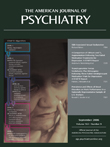To the Editor: Stephen Heres, M.D., and colleagues
(1) succinctly summarized difficulties in integrating inconsistent findings from head-to-head industry-sponsored trials about comparative effectiveness of second-generation antipsychotics. They enumerate several study design and reporting elements that potentially bias studies and contribute to findings favorable for a sponsor’s drug. One additional factor is the frequent discrepancy between the study outcome as reported in the study’s abstract and the actual findings of the study
(2) . For example, in a study sponsored by the manufacturer of olanzapine that compared olanzapine to risperidone
(3), the two medications were not different on 21 out of 25 efficacy measures, yet the abstract emphasized the greater efficacy of olanzapine. In contrast, in a study sponsored by the manufacturer of risperidone that compared the same set of agents
(4), risperidone and olanzapine were found to be not different on 33 out of 37 efficacy measures, including the a priori primary endpoints of the study, yet the abstract emphasized the greater efficacy of risperidone!
The hope that nonindustry-sponsored studies will resolve these discrepancies remains to be realized. In reporting results from phase 1 of their landmark Clinical Antipsychotic Trials of Intervention Effectiveness (CATIE) study comparing first-generation and second-generation antipsychotics
(5), Lieberman and colleagues concluded that “olanzapine was more effective than the other four drugs studied.” The comparison between different second-generation antipsychotics was, however, biased by suboptimal dosing of quetiapine, ziprasidone, and risperidone
(6,
7) and differences in switching rates (51% of olanzapine patients did not have to discontinue a previous antipsychotic in comparison to 45% of risperidone patients, 35% of quetiapine patients, and 30% of ziprasidone patients; the correlation between these switch rates and 8-week all-cause discontinuation was >0.95). Switching antipsychotics among relatively stable, moderately ill patients with schizophrenia always entails high risk
(8) . Neither of these issues was considered in the abstract, analysis, or conclusions.
All studies have design constraints which impact their internal validity and generalizability. To obtain an accurate answer to a clinical question, we consequently need to critically examine and properly integrate all data pertinent to that question. The important findings of CATIE are most usefully considered in the context of the vast database to which it adds.

